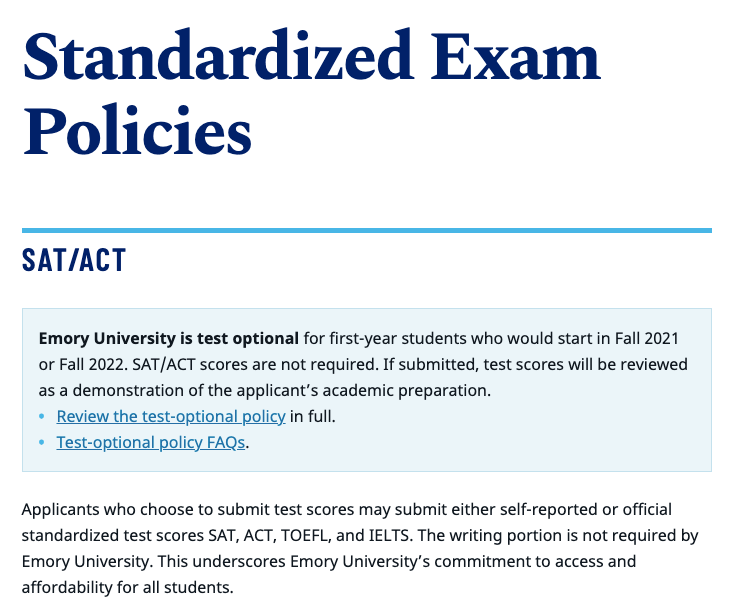Madeleine Ott ’22 | Brianna Bellinghieri ’22
For the sake of all applicants and counselors alike, colleges must be more transparent about their standardized testing policies and evaluation process.
Just like nearly all other facets of society, there has been and continues to be heightened uncertainty within the college admissions process as a result of the COVID-19 pandemic. Early on in the pandemic, the limited availability of testing opportunities across the country resulted in over 600 colleges transitioning to a test optional policy, meaning applicants had the choice of whether or not to submit scores.
In theory, the presence or omission of a score should not impact whether or not a student is accepted. On their admissions websites, many colleges themselves tout this idea of fairness, assuring stressed students that the absence of test scores will not disadvantage or be held against them during the reviewing of applications. For the schools who have implemented test optional policies for decades, this has proven to be the case.
However, for the 600 schools who only recently adopted test optional policies as a result of the pandemic, it seems to be a different story. College admissions expert and best selling author Jeff Selingo explained this distinction in a recent webinar for the EA community, saying, “This group of schools that just went test optional for last fall’s freshman class, they only went through one application cycle so far… so they don’t quite know what they’re looking for yet. And so at least last year, the acceptance rates were higher for those with test scores than those without.”
The limited data from the 2020-2021 application cycle aligns with Selingo’s observation. According to numbers compiled by Compass Education Group, Class of 2021 test submitters had at least a 1.5 “admit rate advantage” at 13 out of the 18 schools with relevant data. In other words, for every 3 students accepted with test scores, there were 2 students accepted without test scores. (From a percentage standpoint, Amherst’s 9% admit rate for submitters and 6% rate for non-submitters corresponds to a 1.5 advantage). Other schools had large gaps between admit rates, such as Emory, who had a 28% rate for submitters and 13% rate for non-submitters.

Photo courtesy of Emory University
However, it is important to keep in mind that these differences could possibly be correlation and not causation. Selingo pointed out that “Maybe students with higher test scores also had better transcripts. You don’t quite know if the test score was the variable that made the difference there, but for the most part, the acceptance rates for those students with test scores were higher.”
However, most colleges insist that test-optional does not disadvantage students. Students and counselors alike are putting their trust into these institutions for major, life-impacting decisions. This is no different at EA. Mariana Ramirez at college counseling says, “When a college says they’re test optional, we take them for their word. We’re not going to different resources and trying to suss out if they really are. We are operating from a place of trust and faith in the colleges.” As a result, some students aren’t submitting less-than-ideal scores despite having taken the test several times. Selingo believes that this absence of scores may raise questions, commenting, “There is an expectation, I think, from some colleges, that students from certain high schools will have test scores. Some of these colleges that are new to test optional, they’ll be like, ‘Wait a second, this school has always sent us great kids with great test scores, now suddenly we see a kid without a test score.’ It doesn’t mean they’re not going to get in, but there will be, maybe in the back of their mind a little bit, ‘I wonder why there’s no test score.’” Considering EA provided a school-day SAT, is relatively affluent, and has an average score of 1350, it could fall in this category.
So why are colleges test-optional and not releasing much information about their new evaluative processes? According to Aviva Legatt, UPenn faculty member and writer for the Philadelphia Inquirer, it may be self-serving incentives. Legatt states that “test-optional will always mean test-preferred” and that “adopting a ‘test-optional’ policy is an easy way for a college to claim equitable admissions practices while maintaining the status quo. The university gets bragging rights; a test-optional policy helps them appear considerate to applicants’ various socioeconomic levels and the realities of the pandemic, during which health and money concerns kept many students away from test halls.” Moreover, she believes that “if colleges were truly committed to not preferencing resourced students as evidenced by test scores, they would adopt a ‘test-blind’ policy and not look at test scores at all.”
That being said, until admissions offices figure out how to be test-optional and admit rates for submitting and non-submitting students are more comparable, colleges need to be more transparent. Students and counselors deserve more information as the college admissions landscape continues to rapidly change. And, despite what colleges say, some students still don’t have full faith in the institutions’ words. William Sargent ‘22 feels “that the reality of test-optional was that students who had access to greater educational opportunities would seem underachieving to universities if they chose not to submit scores.” As a result, according to Sargent, it seems that at least at EA “while no one talked about doing test prep, it was still the unspoken norm to take it.” Colleges must create an environment in which students feel fully informed, so they can trust the institutions where they will spend their next four years.